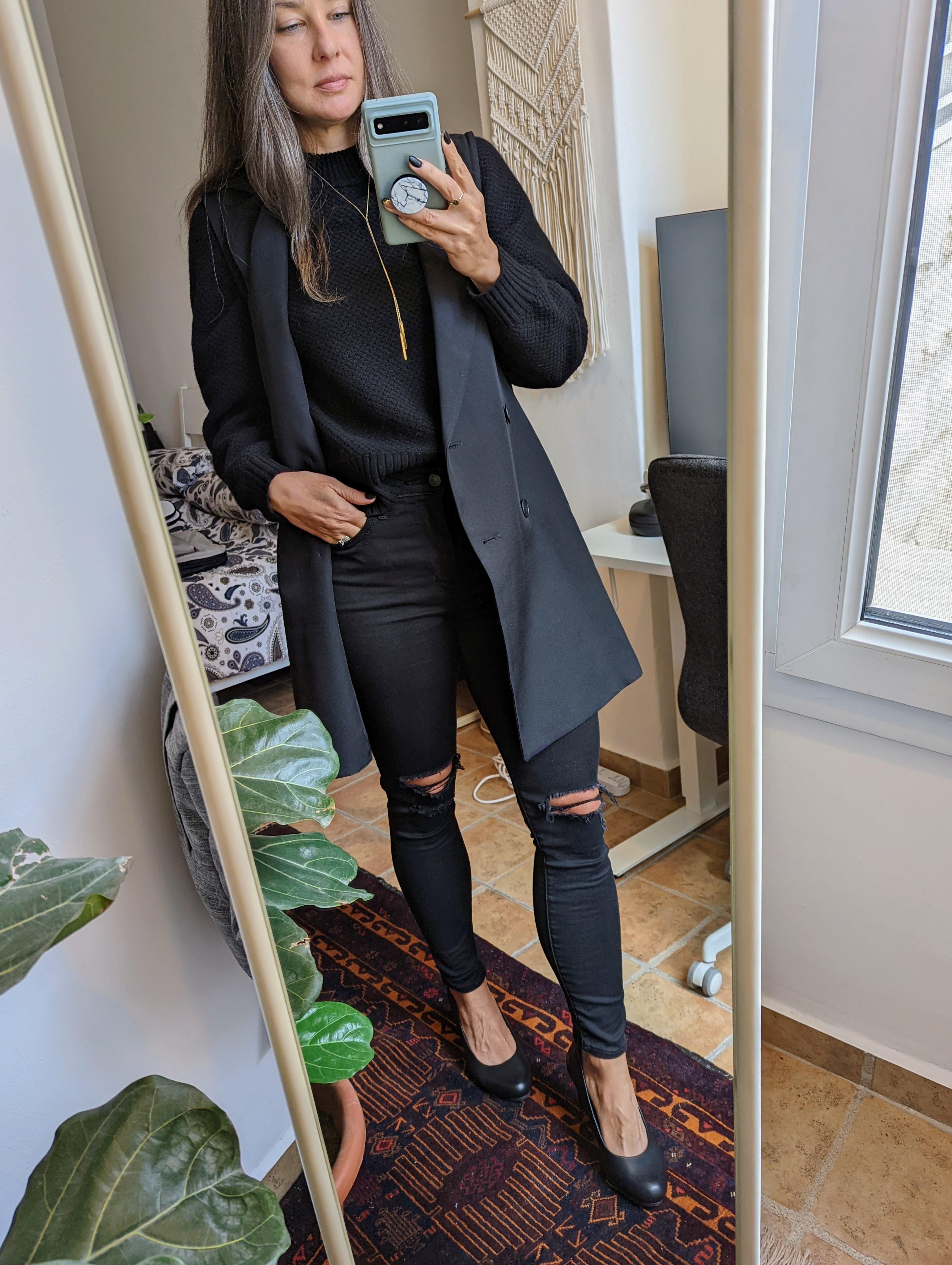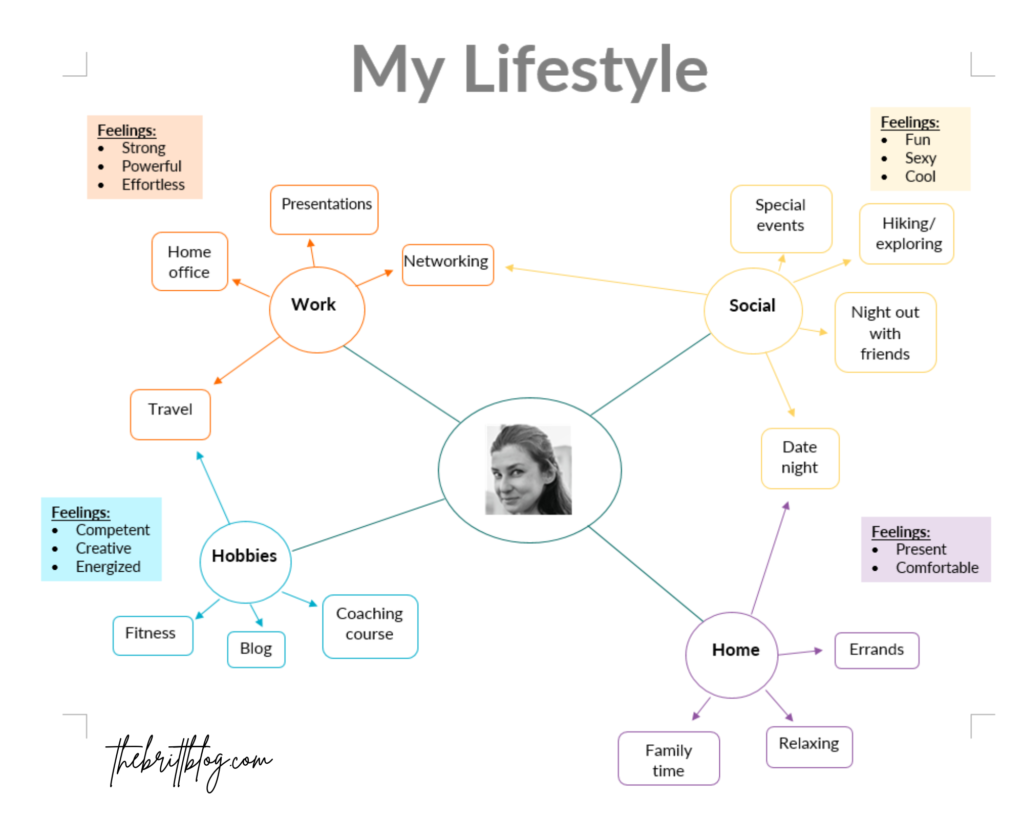As an expat with ADHD who’s working on reducing my footprint, having a no-brainer wardrobe that’s simple and easy to travel with makes sense for me.
I followed the brand VETTA for years. They were all about sustainability and versatile capsule wardrobes with multi-use pieces.
I say “were”, because they closed at the end of March.
I own a few pieces from them, my favorite being a blazer dress that can be worn as a long blazer or a vest if you zip the sleeves off.

To celebrate their contribution to my lifestyle, I want to share how VETTA’s Building a Capsule Wardrobe blog series helped me streamline my wardrobe – and hopefully encourage you to use it, too.
(Remember that I’m not cool enough to get compensated for saying nice things – all of this is purely sharing my experience.)
Getting started
Over the last three years, I’ve moved abroad, built more muscle, and worked from home full-time. Many things I moved to Jordan with stopped fitting my body or lifestyle.
After swapping out pieces here and there, last summer I decided it was time to be more intentional. But there are hundreds of minimalist style resources and bloggers out there, and I can easily get lost in ideas.
Think doomscrolling, but in a sea of neutral outfit photos on Pinterest.
So when I stumbled upon the VETTA’s nine steps for building a personal capsule, I knew I’d be ok: their first step was defining your personal style. A lot of capsule how-to’s jump right into dividing up your closet into keep, donate, and toss, but I needed to begin at the beginning.
Curation Station
However, to really make this process work for me, I decided to use VETTA’s nine steps as a guide rather than rules I had to follow in order.
So I started at Step 4.
Step 4: Align your closet to your lifestyle
This step involves taking stock of the clothes you currently own to see what aligns with how you spend your time. I took this a step further and made a mind map to help me visualize my style.

My map has four main buckets: Work, Social, Home, and Hobbies. Within those buckets, I defined specific activities, some of which overlap (like Travel and Networking). Then, I considered how I wanted to feel in these four areas of my life.
For example, I want to feel “strong”, “powerful”, and “effortless” while I work, even when that’s from a coffee shop. So any pieces for the Work part of my life should make me feel those things – otherwise, they don’t belong.
Knowing what I need my clothes to help me do and also how I’d like to feel in them will help guide my decisions and keep me focused whenever it’s time to go through my closet or approach future purchases.
Armed with my mind map, I felt more confident diving into Step 1.
Step 1: Define your personal style
To define my personal style, I was to make a Pinterest board (oh the irony) capturing style inspiration ideas and then look for themes in what I was pinning.
It was immediately clear that I was drawn to neutrals and good basics, classic shapes, and minimal but edgy details.
Next, I had to give my style a name based on the themes I noticed. Using VETTA’s suggested adjectives, I decided on “Comfort-inspired minimalist with an edge.”
Lastly, I made a second Pinterest board as a Style Guide dedicated to ideas that embodied my newly-named style and/or that I’d actually wear.
Step 2: Assemble a color palette
This turned out to be a lot more fun than I thought. I chose bases, accent colors, and textures based on trends across the pins I’d saved to my Style Guide.
This doesn’t mean that I can’t ever deviate from this palette, but a visual will keep me focused whenever I do go through my closet and approach future purchases.
I should note that I currently own zero things that are velvet or have sequins. We’ll call those the “aspirational” part of my palette.
Step 3: Build a fit guide
To be honest, I didn’t do this step. I have a pretty good sense of what cuts fit me best thanks to some trial and error as my body has changed. I also personally feel you should wear whatever you want, whether it’s “made for” your shape or not. If you like it, wear it.
Step 8: Create a Shopping Wishlist
Spending my month off in December 2022 with family in the US provided the perfect opportunity for the shopping step. To prepare, I created a Wardrobe Planning spreadsheet to track:
- potential items to purchase;
- the part of my lifestyle mind map they represented (i.e., Work, Social, etc.);
- whether it was an addition or replacing something; and
- the URL.
This helped me prioritize the items that I liked (do I really need three pairs of casual black trousers, or just this ONE pair of casual black trousers?) and deal with the impulse to just buy something because “what if I can’t find it again?”
Step 5: Design your ideal capsule wardrobe
The point of this step was identifying items that appear in multiple pins in my Style Guide and writing out up to 30 outfits using the “repeater” items.
My outfits live in my brain, so I didn’t write them out. And honestly, white t-shirts were all over the place. But I can see how mapping out outfit ideas can spark some more creative ways to pair and wear the same things.
I’ll do this soon, so watch this space…
Step 9: Shop Thoughtfully
When making my new purchases, I tried thinking of at least three (ideally more) different outfits I could make with each item – if I couldn’t I didn’t “add to cart.” I stuck to fabrics like washable silk and linen blends that work well here in the Middle East and also wherever we end up next. I also avoided pieces that were dry clean only, since I don’t want to rely on being able to find a good dry cleaner.
Step 6: Clean out your closet
Bringing the new purchases back home from the US to Jordan and incorporating them into my closet was the least scary part of the process for me. My closet tends to be in good shape, since I usually have a constant eye out for things I haven’t worn in a year or that don’t fit anymore (which can drive my husband crazy).
I also try to stick to a “one in, one out” rule, since we don’t have a ton of extra space. However, that rule has yet to apply to my gym/athleisure clothes. The first step is admitting that you have a problem, right?
Step 7: Organize your closet
Your closet organization should align with your personal style and how you like to get dressed.
For me, I hate spending longer than 30 seconds getting dressed, so my closet organization is super basic. My hanging items are organized heaviest to lightest – so from left to right, I have blazers, my heavy cardigan, long sleeved shirts/blouses, short sleeved shirts/blouses, and sleeveless blouses and tank tops. Then, I make sure similar colors hang together.
This way, I don’t spend too much time finding what I want to wear in the color that I want it.
Mindful wardrobe = Calmer brain
Much like I assemble food into meals to minimize anxiety when it comes to cooking, curating my wardrobe helps me leverage my attention span when it comes to how I present myself to the world. It’s now a tool that serves me and my particular lifestyle and needs when it comes to simplifying my environment.
Wardrobe curation will look different for different people, since our needs, lifestyles, and motivations will all be different. What I learned from the VETTA blog is that it’s a living process that never really ends, but that is worth the journey.






